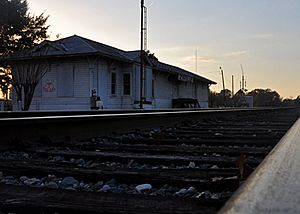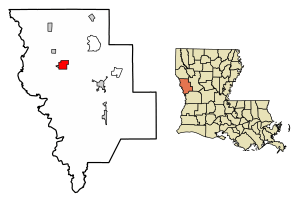Zwolle, Louisiana facts for kids
Quick facts for kids
Zwolle
|
|
|---|---|
| Town of Zwolle | |

Old Zwolle Train Station on Main Street
|
|

Location of Zwolle in Sabine Parish, Louisiana.
|
|
| Country | |
| State | |
| Parish | Sabine |
| Area | |
| • Total | 4.98 sq mi (12.90 km2) |
| • Land | 4.56 sq mi (11.82 km2) |
| • Water | 0.42 sq mi (1.09 km2) |
| Population
(2020)
|
|
| • Total | 1,638 |
| • Density | 359.05/sq mi (138.63/km2) |
| Time zone | UTC-6 (CST) |
| • Summer (DST) | UTC-5 (CDT) |
| Zip Code |
71486
|
| Area Code | 318 |
| FIPS code | 22-83685 |
Zwolle (/zəˈwɒli/ zə-WOL-ee) is a small town in Sabine Parish, Louisiana, United States. A "parish" in Louisiana is like a county in other states. In 2020, about 1,638 people lived there. The town's name comes from Zwolle, a city in the Netherlands.
Contents
History of Zwolle
Early People and Spanish Influence
The first people to live in the Zwolle area were the Mound Builders. They built dome-shaped mounds along Bayou Scie and Bayou San Miguel. These mounds formed a circle around the town. The "bowl" shape of the land helped protect them from storms. These ancient people were ancestors of the North American Indians who lived there when Europeans arrived.
Later, Spain took control of the area. They sent the first non-Native people to live there. A Spanish mission church called Las Cabezas was built at Bayou Scie. Over many years, Spanish soldiers and Native people married each other. People in the area still spoke Spanish until the 1970s. The town was first called Vallecillo in Spanish. This name later became the source for Bayou Scie.
English Settlers and the Railroad
The first English-speaking settlers arrived in Sabine Parish in 1824. They came from places like Mississippi, Alabama, Georgia, and the Carolinas. In 1871, many more settlers moved in. They got land through the homestead act, which allowed people to claim public land.
The Kansas City Southern Railroad (KCS) was built by Arthur Stilwell. He wanted to connect Kansas City to Port Arthur, Texas. In 1893, he ran out of money in Van Buren, Arkansas. Stilwell then went to Zwolle, the Netherlands. There, he met a rich coffee merchant named Jan De Goeijen.
Around 1896, Stilwell and De Goeijen planned to extend the KCS railway to the Gulf of Mexico. De Goeijen visited the area that would become Zwolle. He was impressed by St. Joseph Catholic Church, which was built in 1881. De Goeijen helped Stilwell raise $3,000,000 for the railroad. Because of this, he was allowed to name the new town after his hometown, Zwolle, in the Netherlands.
Town Growth and the Depot
On July 14, 1896, Teofilo “T.” Laroux, a local leader, gave 20 acres of land to the KCS. This land was for a railroad depot and a new town. Paul M. Potts, a cotton farmer, gave another 22.05 acres on October 15, 1896. The Arkansas Townsite Company developed the town of Zwolle. The town officially became a town on June 12, 1898.
The first Kansas City Southern Depot, Zwolle opened on October 26, 1896. A new depot was built around 1914. The railroad brought new wealth to Zwolle. The town became important for moving lumber, oil, and cotton. Even though it's no longer a working train station, the depot is a key part of the town's history. On December 23, 1970, the KCS gave the depot to the town. It was added to the National Register of Historic Places on August 7, 1989.
Geography
Zwolle is located at 31°38′6″N 93°38′33″W / 31.63500°N 93.64250°W. This means it's in the western part of Louisiana. The town covers about 3.7 square miles (9.5 square kilometers). Most of this area is land, but about 0.4 square miles (1.1 square kilometers) is water.
Population Information
| Historical population | |||
|---|---|---|---|
| Census | Pop. | %± | |
| 1900 | 276 | — | |
| 1910 | 973 | 252.5% | |
| 1920 | 909 | −6.6% | |
| 1930 | 1,264 | 39.1% | |
| 1940 | 1,500 | 18.7% | |
| 1950 | 1,555 | 3.7% | |
| 1960 | 1,326 | −14.7% | |
| 1970 | 2,169 | 63.6% | |
| 1980 | 2,602 | 20.0% | |
| 1990 | 1,779 | −31.6% | |
| 2000 | 1,783 | 0.2% | |
| 2010 | 1,759 | −1.3% | |
| 2020 | 1,638 | −6.9% | |
| U.S. Decennial Census | |||
Population in 2020
In 2020, Zwolle had 1,638 people living there. There were 696 households and 415 families.
| Race | Number | Percentage |
|---|---|---|
| White (not Hispanic) | 494 | 30.16% |
| Black or African American (not Hispanic) | 721 | 44.02% |
| Native American | 215 | 13.13% |
| Asian | 5 | 0.31% |
| Pacific Islander | 2 | 0.12% |
| Other/Mixed | 111 | 6.78% |
| Hispanic or Latino | 90 | 5.49% |
Population in 2010
In 2010, there were 1,759 people in Zwolle. Here's a look at the different groups:
- 48.7% Black
- 28.1% White
- 14.1% Native American
- 0.1% Asian
- 3.5% from two or more races
- 5.5% were Hispanic or Latino (of any race)
Education
Zwolle is part of the Sabine Parish School District. All of Zwolle's schools—Zwolle High School, Intermediate, and Zwolle Elementary School—are in one building. About 1,500 students attend this school.
Culture and Festivals
Zwolle Tamale Fiesta
The Zwolle Tamale Fiesta is the town's most famous festival. It started in 1975. The fiesta celebrates the town's Native American and Spanish history. It gets its name from the tamale, a traditional food. Zwolle is known for its own spicy version of the boiled tamale. People believe tamales have been made in the area since the early 1700s.
The festival usually happens on the second weekend of October. It starts on Thursday and ends on Saturday. It used to be held at Zwolle High School. Now, it takes place at the Zwolle Festival Grounds. The fiesta has live music, cultural displays, a parade, a ball, a small carnival, a car show, and a mud bog competition.
Loggers and Forestry Festival
The Loggers and Forestry Festival began in 1995. It honors the people who work in the local horticulture industry. This industry, which involves growing and managing trees, is very important to Zwolle's economy. Each year, a festival queen is chosen in a pageant. The oldest living logger in town is named the king.
This festival is also held at the Zwolle Festival Grounds. It's similar to the Tamale Fiesta, with a parade and mud bog competition. It takes place between late April and early May. It is the town's second-biggest event.
Notable People
- William J. "Bill" Dodd (1909–1991): He was a former Lieutenant Governor of Louisiana. He graduated from Zwolle High School.
- Michael Cutright: He played basketball for the 1989 Denver Nuggets. He also played basketball at Zwolle High School and still lives nearby.
See also
 In Spanish: Zwolle (Luisiana) para niños
In Spanish: Zwolle (Luisiana) para niños



